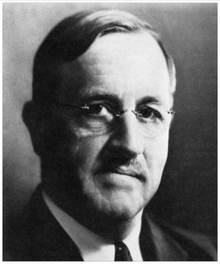Roger Adams
Roger Adams (born January 2, 1889 in Boston , † July 6, 1971 in Champaign , Illinois ) was an American chemist . Together with Paul Sabatier, he is considered a pioneer of hydrogenation .
Life
Adams came from a well-off Boston family descended from US President John Adams . He studied chemistry from 1905 at Harvard University with a degree in 1909 and received his doctorate in 1912 with a thesis in organic chemistry, originally with Henry Augustus Torrey (1871-1910) and after his unexpected death with Charles Loring Jackson . He received a travel grant for postgraduate studies in Germany, where he was with Emil Fischer , Otto Diels and Richard Willstätter in Berlin . After returning in 1913, he was Jackson's research assistant at Harvard University and taught simultaneously at Harvard and Radcliffe College. In 1916 he became an assistant professor at the University of Illinois at Urbana-Champaign with William A. Noyes , where he stayed for the rest of his career. He became a professor and in 1926 as the successor to Noyes head of the chemistry faculty, which he remained until 1954.
He is best known for the development of the Adams catalyst (platinum dioxide hydrate), among other things, for hydrogenation and hydrolysis in organic synthesis.
He made many contributions to the analysis and synthesis of naturally occurring substances such as plant alkaloids and oils. For example, he determined the structure of gossypol , studied the alkaloids of old herbs (Senecia) and Crotalaria , isolated and identified cannabidiol hemp and determined its connection to THC and cannabinol and synthesized analogues of THC and cannabinol. He did research on local anesthetics, partly in collaboration with Abbott Laboratories .
During World War I he headed a special laboratory at the university that researched the organic synthesis of substances that were no longer available in the USA due to the blockade of Germany (the then world market leader in many areas of organic chemistry). This led to the founding of the journal Organic Syntheses . Important Adams employees at the time were Ernest H. Volwiler and Carl S. Marvel . Later he was also active in poison gas research ( adamsite ) at the American University in Washington DC as a group leader. During the Second World War he also made important contributions to the US war effort in the development of synthetic rubber after he was initially denied security clearance by the FBI (among other things because of his research on cannabis , but also because of a lot of misinformation).
He trained numerous organic chemists and worked in schools in the USA.
Prices and memberships
- 1944 Elliott Cresson Medal
- 1945 Davy Medal
- 1946 Priestley Medal
- 1953 corresponding member of the Heidelberg Academy of Sciences
- 1954 Perkin Medal
- 1960 Benjamin Franklin Medal
- 1964 National Medal of Science
- Medal of Merit of the US President
He was a CBE and a ten-time honorary doctorate.
Adams was a member of the National Academy of Sciences , the American Academy of Arts and Sciences (1926), and the American Philosophical Society (1935).
After him is Roger Adams Award named the ACS.
Fonts
- with John R. Johnson Elementary Laboratory Experiments in Organic Chemistry , New York, Macmillan 1928
- 7th edition Macmillan 1979 as Laboratory Experiments in Organic Chemistry (with Charles F. Wilcox)
literature
- D. Stanley Tarbell, Ann Tracy Tarbell: Roger Adams: scientist and statesman. American Chemical Society, Washington DC 1981
- Robert E. Kohler: Adams, Roger . In: Charles Coulston Gillispie (Ed.): Dictionary of Scientific Biography . tape 15 , Supplement I: Roger Adams - Ludwik Zejszner and Topical Essays . Charles Scribner's Sons, New York 1978, p. 1-3 .
Web links
Individual evidence
- ^ Biographical data, publications and academic family tree of Roger Adams at academictree.org, accessed on January 1, 2018.
| personal data | |
|---|---|
| SURNAME | Adams, Roger |
| BRIEF DESCRIPTION | American chemist |
| DATE OF BIRTH | January 2, 1889 |
| PLACE OF BIRTH | Boston |
| DATE OF DEATH | July 6, 1971 |
| Place of death | Champaign |
